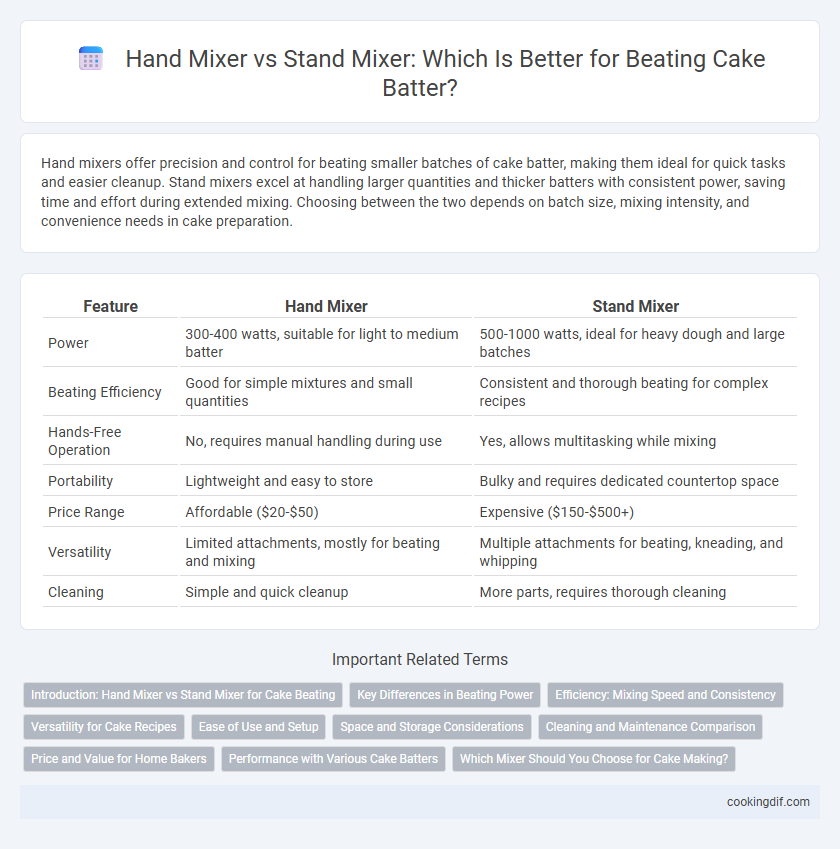Hand mixers offer precision and control for beating smaller batches of cake batter, making them ideal for quick tasks and easier cleanup. Stand mixers excel at handling larger quantities and thicker batters with consistent power, saving time and effort during extended mixing. Choosing between the two depends on batch size, mixing intensity, and convenience needs in cake preparation.
Table of Comparison
| Feature | Hand Mixer | Stand Mixer |
|---|---|---|
| Power | 300-400 watts, suitable for light to medium batter | 500-1000 watts, ideal for heavy dough and large batches |
| Beating Efficiency | Good for simple mixtures and small quantities | Consistent and thorough beating for complex recipes |
| Hands-Free Operation | No, requires manual handling during use | Yes, allows multitasking while mixing |
| Portability | Lightweight and easy to store | Bulky and requires dedicated countertop space |
| Price Range | Affordable ($20-$50) | Expensive ($150-$500+) |
| Versatility | Limited attachments, mostly for beating and mixing | Multiple attachments for beating, kneading, and whipping |
| Cleaning | Simple and quick cleanup | More parts, requires thorough cleaning |
Introduction: Hand Mixer vs Stand Mixer for Cake Beating
Hand mixers and stand mixers both excel in cake beating, but their design and functionality differ significantly. Hand mixers offer portability and control, making them ideal for smaller batches and quick mixing tasks. Stand mixers provide powerful motor strength and hands-free operation, perfect for beating large cake batters consistently and efficiently.
Key Differences in Beating Power
Hand mixers typically offer lower wattage, around 150 to 300 watts, providing sufficient beating power for light to medium tasks like whipping cream or beating eggs. Stand mixers usually feature motors ranging from 250 to 1000 watts, delivering robust and consistent power ideal for heavy dough and dense batters. The key difference lies in motor strength and torque, with stand mixers excelling in sustained high-power beating, ensuring faster and more uniform mixing results.
Efficiency: Mixing Speed and Consistency
Hand mixers offer portable convenience with variable speed settings, making them efficient for light to medium mixing tasks and quick whipping, but they may struggle with maintaining consistent speed under heavy dough or batter loads. Stand mixers provide powerful motors and stable bases that ensure uniform mixing speed and consistency, ideal for dense doughs and prolonged mixing, delivering superior efficiency in handling large quantities without user fatigue. For optimal beating efficiency, stand mixers outperform hand mixers in speed stability and consistency, especially in demanding baking scenarios.
Versatility for Cake Recipes
A hand mixer offers convenience and portability, making it ideal for simple cake recipes and lighter batters with quick mixing requirements. Stand mixers provide superior power and versatility, handling dense doughs, cream, and large batches effortlessly while offering multiple attachments for diverse cake preparation tasks. Choosing between the two depends on recipe complexity and kitchen space, with stand mixers favored for frequent bakers seeking multi-functionality.
Ease of Use and Setup
Hand mixers offer greater ease of use and faster setup for beating tasks, making them ideal for quick mixing and small batches. Stand mixers require more time to assemble and position but provide hands-free operation and consistent power, which is beneficial for prolonged or heavy-duty beating. Choosing between the two depends on the frequency and volume of mixing, with hand mixers excelling in convenience and stand mixers in performance stability.
Space and Storage Considerations
Hand mixers offer compact designs that fit easily into small kitchen drawers, making them ideal for limited counter space and easy storage. Stand mixers require more countertop room and often come with bulky attachments, necessitating dedicated storage areas or kitchen cabinets. Choosing between the two depends on available kitchen space and frequency of use, with hand mixers excelling in portability and stand mixers favoring stable, heavy-duty mixing tasks.
Cleaning and Maintenance Comparison
Hand mixers offer a lightweight, easily portable option with detachable beaters that simplify cleaning under running water or in a dishwasher. Stand mixers feature larger, more powerful motors and attachments but often require more effort to clean due to their bulk and non-removable parts. Regular maintenance for stand mixers includes wiping the splash guard and motor housing, while hand mixers typically need minimal upkeep beyond cleaning the beaters and casing.
Price and Value for Home Bakers
Hand mixers typically range from $20 to $60, offering an affordable option for basic beating tasks in home baking. Stand mixers, priced between $200 and $500, provide powerful motors and multiple attachments, delivering long-term value for frequent bakers seeking efficiency and versatility. Evaluating baking frequency, budget, and desired features helps home bakers determine the best mixer investment for their needs.
Performance with Various Cake Batters
A stand mixer offers superior power and consistent speed, making it ideal for handling dense cake batters like pound cake or fruitcake efficiently. Hand mixers provide greater maneuverability and control, which works well for lighter batters such as sponge cakes or chiffon cakes that require gentle folding. Both tools vary in performance depending on the cake batter's texture, with stand mixers excelling in heavy-duty mixing and hand mixers suited for more delicate preparations.
Which Mixer Should You Choose for Cake Making?
Hand mixers offer lightweight versatility and precise control for beating cake batters, making them ideal for small to medium batches and delicate mixing tasks. Stand mixers deliver powerful, consistent mixing with multiple attachments, perfect for large quantities and heavy-duty cake recipes requiring thorough aeration. Choose a hand mixer for portability and ease or a stand mixer for performance and multitasking in cake preparation.
Hand Mixer vs Stand Mixer for beating Infographic

 cookingdif.com
cookingdif.com